Epidemiology Medterm – Flashcards
Unlock all answers in this set
Unlock answersquestion
Epidemiology
answer
study of the DISTRIBUTION and DETERMINANTS of health-related states or events in SPECIFIED POPULATIONS and the application of this study to the control of health problems
question
Epidemiology's goal
answer
is prevention.
question
Epidemiology is a_____________science.
answer
population-based
question
Five objectives of Epidemiology
answer
1. Identify etiology (causes) of disease and relevant risk factors 2. Determine the burden (extent) of the disease in the community 3. Study natural history of disease and prognosis of disease 4. Evaluate existing and new preventive and therapeutic measures and modes of healthcare delivery 5. Provide the foundation for developing public policy related to disease prevention and health promotion
question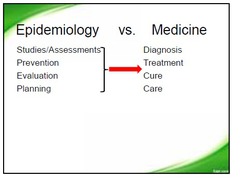
Epidemiology differs from clinical medicine. How?

answer
Epidemiology informs the clinical practice of medicine Example: Diagnosis and prognosis are based on population data. • Preventive medicine -We are concerned with how we can prevent disease from occurring, not curing it once it has occurred • Population science - Our unit of study are groups of people, not individuals -We advocate for the allocation of effort ; resources at the community level
question
Epidemiology informs medicine
answer
Example: Prognosis A patient asks a doctor, "How long do I have to live?'' The doctor usually answers on the basis of : Experience with large groups of patients who had the same disease were observed at the same stage of disease received the same treatment
question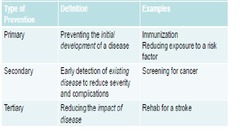
Three types of prevention and examples of each PRIMARY SECONDARY TERTIARY

answer
1. Primary: Preventing the initial development of a disease; eg., immunization 2. Secondary: Early detection of existing disease to reduce severity and complications; eg., cancer screening 3. Tertiary: Reducing the impact of disease; eg., rehabilitation
question
Successes in Epidemiology, examples
answer
1. Sanitation 2. Vaccination 3. Water quality 4. Disease screening 5. Health promotion/disease prevention campaigns
question
Epidemiology utilizes both _______ and ________ approaches for study
answer
descriptive AND analytical
question
Descriptive Epidemiology
answer
Characterizes disease in populations - Who? When? Where?
question
Analytical Epidemiology:
answer
is there an association between risk factor and disease?
question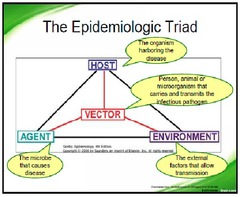
Diseases result from an interaction of the Epidemiologic Triad HOST AGENT ENVIRONMENT

answer
1. Host: The organism harboring the disease 2. Agent: The microbe that causes disease 3. Environment: The external factors that allow transmission
question
Vector
answer
Person, animal or microorganism that carries and transmits the infectious pathogen
question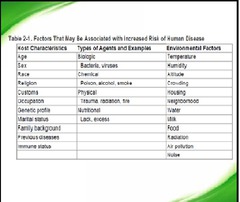
Factors that may be associated with an increased/decreased risk of human disease (examples of each)

answer
1. Host characteristics 2. Agents 3. Environmental factors
question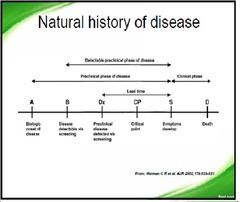
Natural history of disease, Stages, severity of disease A. Pre-Clinical vs. Clinical PRECLINICAL? SUBCLINICAL ? PERSISTENT? LATENT?

answer
Clinical vs. Nonclinical Disease • Clinical Disease - Characterized by signs and symptoms • Nonclinical Disease (i.e., not apparent) - Preclinical: not apparent but will progress - Subclinical: not apparent and won't progress - Persistent, i.e., chronic: a person filos to "shake-off" the infection, and it persist for years, at times for life. - Latent: silent, not active; an infection with no active multiplication of the agent, as the viral nucleic acid is incorporated into the nucleus of a cell as a provirus. 1. Biological onset 2. Detectable by screening 3. Symptom onset 4. Seek medical care, diagnosis 5. Treatment 6. Outcome: cure, death Stages, severity of disease: VIEW SLIDE PICTURE BELOW
question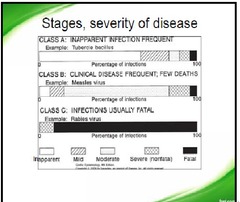
Disease carrier - Carrier Status

answer
an individual who harbors the infectious organism but does not have any evidence of clinical illness. the person can still infect other people.
question
Disease transmission
answer
Direct: Person-to-person contact • Indirect - occurs through Common vehicle such as contaminated air or water supply, or a vector (1) Single exposure (2) Multiple exposures (3) Continuous exposure (4) Vector
question
Incubation period
answer
The interval from receipt of infection to the time of onset of clinical illness
question
Endemic
answer
he habitual or "background" presence of disease that is normal for a given geographic area
question
Epidemic:
answer
the occurrence of a disease at a level that is higher than normal background or expected for a specific community or geographic area
question
Pandemic:
answer
an epidemic that spans more than one country
question
Herd immunity
answer
the resistance of a group of people to a disease to which a large proportion of the members of the group are immune - Basis likelihood of encountering susceptible or infected person - eg. measles ~94% immune/vaccinated before herd immunity of population
question
Disease outbreaks
answer
an occurrence of disease greater than would otherwise be expected at a particular time and place, Types (for example): 1. Foodborne 2. Waterborne 3. Healthcare facility What is an outbreak? - an occurrence of disease greater than would otherwise be expected at a particular time and place - Could be small and localized or widespread and impact thousands of people - Could be two epidemiologically linked cases of a rare disease
question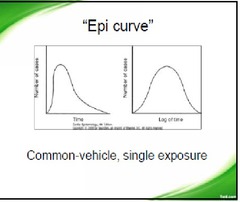
"Epi curve"

answer
Common-vehicle, single exposure a graphical presentation of number of cases over time
question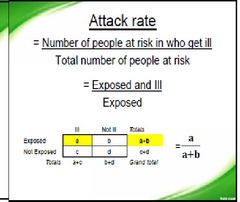
Attack rate

answer
= Number of people at risk in who get ill/ Total number of people at risk
question
Common measures of disease
answer
1. Proportions: the fraction of the population that is affected by disease, death 2. Rates: how fast disease, death is occurring in the population
question
Morbidity measures
answer
incidence rate and prevalence rate
question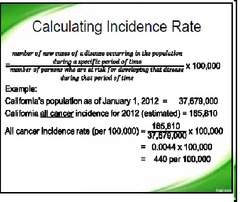
Incidence rate

answer
i. The number of new cases of a disease that occur during a specified period of time in a population at risk for developing the disease ii. calculation of - numerator and denominator (persons, person-time) iii. measure of disease risk
question
incidence rate

answer
• Choice of multiplier is arbitrary (1,000, 10,000, 100,000) • NEW onset cases (assumed population at risk is comprised of persons who did not have the disease previously) • Serves as a measure of risk • Can be calculated in any group, subgroup, population, subpopulation • Denominator must contain only those who have the potential to become part of the numerator (eg., cervical cancer & men) • Units of denominator consist of - persons (when followed for entire period) ("cumulative incidence") or - person-time (when followed for portion of time period)
question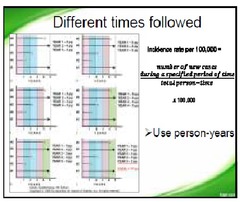
person-years

answer
number of new cases during a specified period of time ________________________________________ total person time X1000
question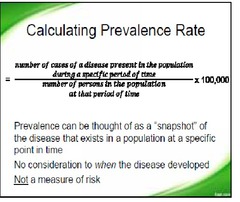
Prevalence rate

answer
i. The number of existing cases a disease in the population at a specific time divided by the number of persons in the population at that time ii. calculation of iii. measure of disease burden iv. point and period prevalence v. survival is an important factor c. Interrelationship between incidence and prevalence d. Disease surveillance is used to identify/count incident cases
question
Point prevalence
answer
- Prevalence of disease at a certain point in time - "Do you currently have x disease?"
question
• Period prevalence
answer
- Prevalence of disease during a certain time period - "Have you had x disease during the last # years?"
question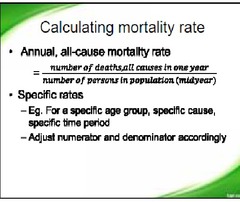
Mortality (death) rate

answer
i. Number of deaths overall/due to a certain cause/disease that occur during a specified time divided by the number in the population (midyear) ii. calculation of iii. all-cause, cause-specific
question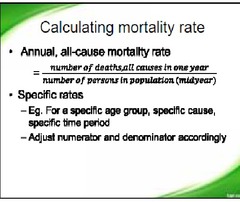
Case-fatality rate (percent)

answer
Percentage of people with a specific disease who die from the disease
question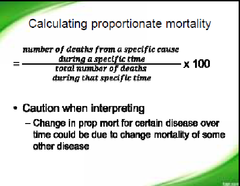
Proportionate mortality (proportion)

answer
Proportion of all deaths due to a specific cause
question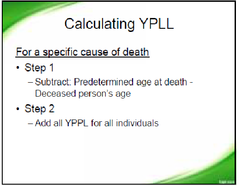
Years of potential life lost

answer
Measure of premature mortality (early death)
question
Age-adjustment
answer
age-adjusted rates: age is arguably the most important known factor related to death; when comparing rates of disease, mortality in populations it is important to adjust for age is it important know indirect and direct age adjustments?
question
Problems with mortality data
answer
• DC coded for underlying cause of death, not multiple cause/contributing cause • Reflect medical opinion • Varying quality, completeness • Changes in ICD coding • Changes in definition of disease • Not published promptly, multi-year delay
question
Measuring Prognosis (survival): standardized from time of diagnosis
answer
1. Case-fatality rate - Best for short-term, acute conditions 2. Five-year survival rate - percentage of patients alive 5 years after diagnosis or treatment 3. Median survival time 4. Observed survival (life table) approach 5. Kaplan-Meier method Did not go over 4 and 5
question
Lead time:
answer
made earlier because of screening for disease artificially lengthens survival time
question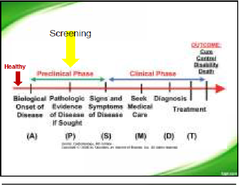
Screening test

answer
1. Laboratory tests that help to identify people at increased risk for a condition or disease before they have symptoms 2. Help detect disease in its earliest and most treatable stages 3. Contrast with a diagnostic test which confirms a diagnosis in person who already has signs/symptoms of a disease 4. Oftentimes, continuous test value must be dichotomized into positive/negative, yes/no result for interpretation
question
Validity
answer
ability of a test to distinguish between who has a disease and who does not includes: sensitivity and specificity
question
Sensitivity

answer
i. level at which test correctly identifies those who have the disease ii. calculation of iii. interpretation of
question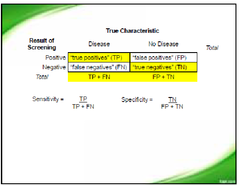
Specificity

answer
i. level at which test correctly identifies those who do not have the disease ii. calculation of iii. interpretation of
question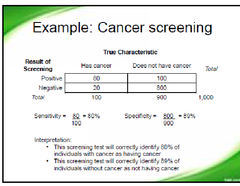
example of screening

answer
```
question
Predictive Value (precision) -
answer
probability the patient has/does not have the disease if he/she tests positive/negative
question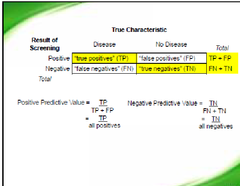
Positive Predictive Value (PPV)

answer
i. the proportion of patients who test positive that actually have the disease (eg., correct diagnosis) ii. calculation of iii. interpretation of
question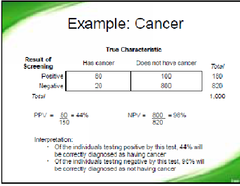
Negative Predictive Value (NPV)

answer
i. the proportion of patients who test negative that don't actually have the disease ii. calculation of Interpretation: • Of the individuals testing positive by this test, 44% will be correctly diagnosed as having cancer • Of the individuals testing negative by this test, 98% will be correctly diagnosed as not having cancer
question
Reliability (reproduceability)

answer
a. Intra-subject (within the same subject) b. Intra-observer (within the same observer) c. Inter-observer (between observers)
question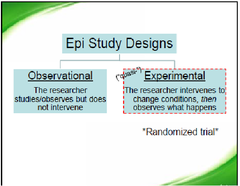
Experimental

answer
The researcher intervenes to change conditions, then observes what happens a. Randomized Trials
question
Observational
answer
The researcher studies/observes but does not intervene a. Case-Control b. Cohort



